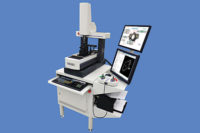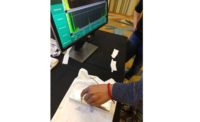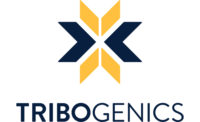Laser Ultrasonics: The Next Big Nondestructive Inspection Technology?
A Frost & Sullivan Market Insight

Laser ultrasonic testing (LUT) is a non-contact, nondestructive inspection technology that that uses lasers to generate and detect ultrasonic waves in the component under test. Laser ultrasonics may not quite be the buzz word in nondestructive testing (NDT) yet, but a handful of industries have recognized its benefits and have implemented a laser ultrasonic system to good effect. This article will provide a brief description of the technology and its applications, and analyze whether laser ultrasonics has the potential of becoming a standard technology in industrial inspection applications.

In late 1980s, the Industrial Materials Institute (IMI) of the National Research Council of Canada (NRC) began a large scale program in laser ultrasonics with Dr. Jean Pierre Monchalin, widely considered as the single most knowledgeable expert in this field, at the helm. This group was relatively successful in designing a cost effective system. During this time, Lockheed Martin also started development of laser ultrasonic systems for aircraft composite component inspection. The company recognized, as early as the 80s, that composite materials had a critical role to play in the future of aircraft design and construction.
Although these landmarks did not materialize into commercial products being sold at a large scale, it made the industry realize the potential and advantages of laser ultrasonics. The actual commercialization of laser ultrasonics started in the 1990s, with several companies attempting to gain a foothold in a market that was still considered nascent and the technology still immature. In the late 1990s, Tecnar Automation licensed its laser ultrasonic technology for wall thickness measurement of seamless steel tubes from NRC, which was developed in collaboration with Timken Steel. This solution for wall thickness measurement of seamless steel tubes is considered to be the single biggest success of laser ultrasonics. Tecnar Automation is the sole licensee of this technology and sells this system to steel tube mills globally, with considerable success.
Wall thickness measurement of seamless steel tubes has been the most successful application for laser ultrasonics. In this application, a laser ultrasonic system makes wall thickness measurements on tubes while they are in production. Hence, if any corrections need to be made, they can be made immediately. In effect, the laser ultrasonic system is performing in-line inspection. This is the biggest benefit of a laser ultrasonic test system in the wall thickness measurement of seamless steel tubes.
According to Dr. Marc Choquet, VP Laser NDE at Tecnar Automation, “The only other technique for in-line inspection on seamless steel tubes was gamma ray technology which had severe limitations.”
In gamma ray inspection-apart from harmful radiations-restrictions on wall thickness range and position and shape of the tube limited the accuracy and efficiency of inspection.
“Well, now we go a little bit into the realm of possible,” says Dr. Marvin Klein, Manager, Laser Ultrasonics Products Group at Intelligent Optical Systems. “Each person you ask is going to give you a different answer on the future applications for laser ultrasonics, but for me automated weld inspection is a very promising application.”
Intelligent Optical Systems has researched the automated weld inspection market for the past five years and has developed a system for this application.
Dr. Klein says, “Our system is particularly good for laser welds as they have generally very high requirements of integrity and it is a fully automated process.”
In addition to the aforementioned applications, research is also being conducted in a number of new areas, such as inspection of adhesives in the automotive body assembly, detection of lap joint corrosion in an aluminum airframe and determination of elastic constants on ceramics and ceramic-metal composites up to 1,800°C (3,300°F). There are no industrially installed systems for these applications, but there is significant potential in some of them.

Dr. Choquet says, “It takes a long track record before the technology is accepted in aerospace industries and steel mills without any questions. So we have probably passed the introduction phase, in that it is no longer a new technology but it is still not a standard technology.”
One of the major challenges laser ultrasonic technology faces is price. Industrial laser ultrasonic systems range from $500,000 to $2 million, although R&D systems are less expensive. This is a major setback for end-users with limited budgets. Although, these prices may seem quite high, when measured against cost savings they can often be justified. This is another challenge for the laser ultrasonic equipment manufacturers; educating end-users on the actual savings that could be achieved by installing a laser ultrasonic system as apposed to other inspection technologies.
Despite these challenges and slow acceptance of this technology, several experts strongly believe that it has the potential to become the standard technology in certain applications. According to Dr. Klein, “One of the ways of assessing market acceptance is by the number of enquiries, and for us that number has gone up considerably. In some enquiries, people are already aware of the technology.” Dr. Choquet concurs with that statement, “There has been an increase in our sales for the seamless steel tube inspection system.”
In the late 1990s, Tecnar Automation licensed its laser ultrasonic technology for wall thickness measurement of seamless steel tubes from NRC and Timken Steel. This solution is considered to be the single biggest successof laser ultrasonics.
Despite its challenges and slow acceptance, several experts strongly believe that laser ultrasonics has the potential to become the standard technology in certain applications.

An application of seamless steel-tube wall-thickness monitoring. Source: Intelligent Optical Systems
Laser ultrasonic testing (LUT) is a non-contact, nondestructive inspection technology that that uses lasers to generate and detect ultrasonic waves in the component under test. Laser ultrasonics may not quite be the buzz word in nondestructive testing (NDT) yet, but a handful of industries have recognized its benefits and have implemented a laser ultrasonic system to good effect. This article will provide a brief description of the technology and its applications, and analyze whether laser ultrasonics has the potential of becoming a standard technology in industrial inspection applications.

The IOS AIR-1550-TWM Laser Ultrasonic Receiver. Source: Intelligent Optical Systems
A Brief History: Origin of Laser Ultrasonics for Industrial Applications
In theory, laser ultrasonics started with the development of lasers. Generation of ultrasonic waves was one of the first applications of lasers. However, detection of these waves posed the biggest challenge for its adoption in industrial applications. In the early 1980s, Krautkramer, now a part of GE Measurement and Control Solutions, began the development of laser ultrasonics for industrial applications. It was unsuccessful as the technology had not advanced, yet, to a level that could permit practical cost effective solutions. However, Krautkramer can be credited with being the first company to venture into the commercialization of laser ultrasonics, which, until then, remained a research topic in universities and R&D centers.In late 1980s, the Industrial Materials Institute (IMI) of the National Research Council of Canada (NRC) began a large scale program in laser ultrasonics with Dr. Jean Pierre Monchalin, widely considered as the single most knowledgeable expert in this field, at the helm. This group was relatively successful in designing a cost effective system. During this time, Lockheed Martin also started development of laser ultrasonic systems for aircraft composite component inspection. The company recognized, as early as the 80s, that composite materials had a critical role to play in the future of aircraft design and construction.
Although these landmarks did not materialize into commercial products being sold at a large scale, it made the industry realize the potential and advantages of laser ultrasonics. The actual commercialization of laser ultrasonics started in the 1990s, with several companies attempting to gain a foothold in a market that was still considered nascent and the technology still immature. In the late 1990s, Tecnar Automation licensed its laser ultrasonic technology for wall thickness measurement of seamless steel tubes from NRC, which was developed in collaboration with Timken Steel. This solution for wall thickness measurement of seamless steel tubes is considered to be the single biggest success of laser ultrasonics. Tecnar Automation is the sole licensee of this technology and sells this system to steel tube mills globally, with considerable success.
Current Applications for Laser Ultrasonics and Future Potential
Currently, there are three known industrial application areas for laser ultrasonics: wafer inspection, inspection of composite components in aircrafts and wall thickness measurement of seamless steel tubes. A laser ultrasonic test system for composite components inspection was first implemented by Lockheed Martin, although, currently there are three companies that sell such an inspection system: Tecnar Automation, PaR Systems-the company that took over the technology developed by Lockheed Martin for the Joint Strike Force (JSF) program-and iPhoton Solutions.Wall thickness measurement of seamless steel tubes has been the most successful application for laser ultrasonics. In this application, a laser ultrasonic system makes wall thickness measurements on tubes while they are in production. Hence, if any corrections need to be made, they can be made immediately. In effect, the laser ultrasonic system is performing in-line inspection. This is the biggest benefit of a laser ultrasonic test system in the wall thickness measurement of seamless steel tubes.
According to Dr. Marc Choquet, VP Laser NDE at Tecnar Automation, “The only other technique for in-line inspection on seamless steel tubes was gamma ray technology which had severe limitations.”
In gamma ray inspection-apart from harmful radiations-restrictions on wall thickness range and position and shape of the tube limited the accuracy and efficiency of inspection.
“Well, now we go a little bit into the realm of possible,” says Dr. Marvin Klein, Manager, Laser Ultrasonics Products Group at Intelligent Optical Systems. “Each person you ask is going to give you a different answer on the future applications for laser ultrasonics, but for me automated weld inspection is a very promising application.”
Intelligent Optical Systems has researched the automated weld inspection market for the past five years and has developed a system for this application.
Dr. Klein says, “Our system is particularly good for laser welds as they have generally very high requirements of integrity and it is a fully automated process.”
In addition to the aforementioned applications, research is also being conducted in a number of new areas, such as inspection of adhesives in the automotive body assembly, detection of lap joint corrosion in an aluminum airframe and determination of elastic constants on ceramics and ceramic-metal composites up to 1,800°C (3,300°F). There are no industrially installed systems for these applications, but there is significant potential in some of them.

The Tecnar Automation LUT Probe online. Source: Intelligent Optical Systems
Is There a Market for Laser Ultrasonics?
Although industrial application of laser ultrasonics has been around for over a decade, it is still a relative unknown amongst most end-users. As is the case with any new NDT technology, acceptance continues to remain a hindrance. The two major applications of laser ultrasonics target the aerospace industry and steel mills, which are considered conservative when it comes to new technology adoption.Dr. Choquet says, “It takes a long track record before the technology is accepted in aerospace industries and steel mills without any questions. So we have probably passed the introduction phase, in that it is no longer a new technology but it is still not a standard technology.”
One of the major challenges laser ultrasonic technology faces is price. Industrial laser ultrasonic systems range from $500,000 to $2 million, although R&D systems are less expensive. This is a major setback for end-users with limited budgets. Although, these prices may seem quite high, when measured against cost savings they can often be justified. This is another challenge for the laser ultrasonic equipment manufacturers; educating end-users on the actual savings that could be achieved by installing a laser ultrasonic system as apposed to other inspection technologies.
Despite these challenges and slow acceptance of this technology, several experts strongly believe that it has the potential to become the standard technology in certain applications. According to Dr. Klein, “One of the ways of assessing market acceptance is by the number of enquiries, and for us that number has gone up considerably. In some enquiries, people are already aware of the technology.” Dr. Choquet concurs with that statement, “There has been an increase in our sales for the seamless steel tube inspection system.”
Conclusion
There are undoubtedly clear advantages to laser ultrasonics in seamless steel tube inspection and composite component inspection applications. To put things in perspective, it has all the benefits of conventional ultrasonic testing, such as accuracy and speed, in addition to being non-contact, flexible and fully automated. Although steel mills and aerospace industries have been traditionally conservative in embracing new technologies, they are gradually realizing the effectiveness of this technology. Laser Ultrasonics is expected to eventually become a standard technology for these applications with industry experts estimating anywhere in the region of 3-5 years for large scale market adoption. There are no specific technology barriers to this inspection technique, however, end-user and industry mindset will need to change for this technology to become standardized. NDTTech Tips
In the early 1980s, the development of laser ultrasonics for industrial applications was unsuccessful as the technology had not advanced, yet, to a level that could permit practical cost effective solutions.In the late 1990s, Tecnar Automation licensed its laser ultrasonic technology for wall thickness measurement of seamless steel tubes from NRC and Timken Steel. This solution is considered to be the single biggest successof laser ultrasonics.
Despite its challenges and slow acceptance, several experts strongly believe that laser ultrasonics has the potential to become the standard technology in certain applications.
Looking for a reprint of this article?
From high-res PDFs to custom plaques, order your copy today!







